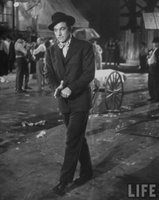Srgt. Sullivan and the Black Hand
0 Comments Published by Jane on Monday, December 01, 2008 at 8:01 PM. It appears my great-grandfather, Srgt. Maurice Sullivan, had a number of run-ins with an Italian organized crime group called the Black Hand.
It appears my great-grandfather, Srgt. Maurice Sullivan, had a number of run-ins with an Italian organized crime group called the Black Hand. During the early 1900's, residents of the "Little Italies" of many eastern industrialized urban areas had to contend with a crude form of protection racket known as "La Mano Nera" or "the Black Hand." Those members of the local community who were better off financially might receive an anonymous note demanding that a sum of money be paid to the writer. If payment was not forthcoming, victims were typically warned that they could expect to have their businesses bombed or the safety of their family members jeopardized. Customarily, the extortion demand was signed with a crude drawing of a black hand. While the receiver of the letter (as well as other members of the community) were led to believe that the Black Hand was a large and powerful organization, it is more likely that the extortion was the work of individuals or a small group of offenders who used their victims' fear of secret societies (and often their fear of the police) to coerce payment.
This Boston Globe July 28, 1922 article describes a Black Hand trial that Srgt. Sullivan testified in. A local North End family was receiving blackmail letters and it appears my great-grandfather was trying to help outwit the gang members. Unfortunately, his fake money ruse did not work, and a murder did occur.
Sergt Maurice Sullivan of Station 1 said that on Dec 28 he and Tessarrero were at Unity st with Scarpone, his wife and his brother, Alphonso Scarpone, who lived with them. After reading a letter, Sergt. Sullivan cut up some newspapers in the shape of currency, made them into a bundle and gave them to Alphonso Scarpone. About 7:10 o'clock he went to the Charter st playground and remained until 8:35. Shortly before 8 o'clock Alphonso Scarpone passed him. Fifteen minutes later a man came up the steps leading into Charter st, looked around and went in the same direction as Scarpone. Scarpone only partly followed his instructions, Sergt Sullivan said.Gene Kelly starred in a 1950 movie called The Black Hand about a group in New York City. Sometime I will have to watch it.
Sergt Sullivan said that at 10:30 pm on the same day he went to the steps leading into the North End playground. There he saw a bush with a piece of red cloth tied to it and footprints in the snow about it.
It appears my great-grandfather ran into some very dangerous characters while patroling his beat in the North End.
Labels: Sullivan


0 Responses to “Srgt. Sullivan and the Black Hand”
Post a Comment